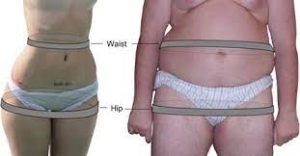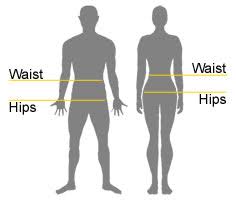
 The waist–hip ratio or waist-to-hip ratio (WHR) is the ratio of the circumference of the waist to that of the hips.
The waist–hip ratio or waist-to-hip ratio (WHR) is the ratio of the circumference of the waist to that of the hips.
This is calculated as waist measurement divided by hip measurement
The WHR has been used as an indicator or measure of health, fertility, and the risk of developing serious health conditions.
WHR correlates with perceptions of physical attractiveness.
In a lean person, the waist can be measured at its narrowest point, while for an obese person, it may be measured at about 3 cm above the navel.
The hip is measured at its widest portion of the buttocks at left, and at the greater trochanters at right.
WHO:waist circumference measured at the midpoint between the lower margin of the last palpable ribs and the top of the iliac crest.
Hip circumference should be measured around the widest portion of the buttocks, with the tape parallel to the floor.
The United States National Institutes of Health and the National Health and Nutrition Examination Survey used results obtained by measuring at the top of the iliac crest.
Waist measurements are usually obtained by laypersons by measurings around the waist at the navel.
These measurements may underestimate the true waist circumference.
The WHR is used as an indicator or measure of health, and as a risk factor for developing serious health conditions.
WHO: states that abdominal obesity is defined as a waist–hip ratio above 0.90 for males and above 0.85 for females, or a body mass index (BMI) above 30.0.
Total cholesterol levels are usually higher in persons with predominant abdominal obesity, defined as a waist-to-hip circumference ratio of ≥ 0.8 for women and ≥ 1.0 for men.
WHR is a more efficient predictor of mortality in older people (>75 years of age) than waist circumference or BMI.
If obesity is redefined using WHR instead of BMI, the proportion of people categorized as at risk of heart attack worldwide increases threefold.
WHR may be less accurate in individuals with a BMI of 35 or higher.
With a BMI of 35 or higher an increased WHR may result from increased abdominal fat or decreased lean muscle mass around the hips.
The body fat percentage is considered to be an even more accurate measure of relative weight.
The waist–hip ratio takes account of the differences in body structure:
It is possible for two people of the same sex to have different body mass indices but the same waist–hip ratio, or to have the same body mass index but different waist–hip ratios.
WHR has been shown to be a better predictor of cardiovascular disease than simple waist circumference and body-mass index.
Measuring waistline and comparing it to hip size might be a better way to predict heart disease risk than a widely used body mass index.
Waist circumference, particularly Waist-to-height ratio, is a better indicator of cardiovascular risk factors than the waist–hip ratio, body fat distribution, and hypertension in type 2 diabetes.
The stress hormone cortisol is regulated by the hypothalamic-pituitary-adrenal (HPA) axis and has been associated with higher levels of abdominal fat and therefore a higher WHR.
Abdominal fat is a marker of visceral fat which is stored around important internal organs such as the liver, pancreas and intestines and has greater blood flow and more receptors for cortisol than peripheral fat.
The greater the number of cortisol receptors, the more sensitive the visceral fat tissue is to cortisol.
This heightened sensitivity to cortisol stimulates fat cells to further increase in size.
Women who have a combination of normal BMI and high WHR have elevated cortisol reaction to stressors and fail to habituate to repeated stress, compared to women with normal WHR.
In general, adults with growth hormone deficiencies also have increased WHRs.
Males with congenital adrenal hyperplasia, determined by CYP21A2 mutations, have increased WHRs.
Women with high WHR (0.80 or higher) have significantly lower pregnancy rates than women with lower WHRs (0.70–0.79), independent of their BMIs.
Men with WHRs around 0.9, similarly, have been shown to be more healthy and fertile with less prostate cancer and testicular cancer.
WHR is an accurate somatic indicator of reproductive endocrinological status and long-term health risk.
Among girls with identical body weights, those with lower WHRs show earlier pubertal endocrine activity, as measured by high levels of lutenizing hormone and follicle-stimulating hormone, as well as estradiol activity.
I’m artificial insemination a study reported that a 0.1 unit increase in WHR decreases the probability of conception per cycle by 30% after adjustment for age, obesity, reasons for artificial insemination, cycle length and regularity, smoking, and parity.
Menopause hormonal changes are also associated with an increase in WHR independent of increases in body mass.
Large premenopausal WHRs are associated with lower estradiol levels and variation in age of menopause onset.
Circulating estrogen preferentially stores lipid deposits in the gluteofemoral region, including the buttocks and thighs, and evidence suggests that menopause-associated estrogen deficiency results in an accumulation of adipose deposits around the abdomen.
Menopause-induced changes in body fat distribution can be counteracted with hormone replacement therapy.
In contrast, aging males gradually accumulate abdominal fat, and hence increased WHR, in parallel with declining androgen levels.
Cognitive ability in children correlates to their mother’s waist–hip ratio, a proxy for how much fat she stores on her hips.
Children whose mothers had wide hips and a low waist–hip ratio score highest on cognitive ability, suggesting that fetuses benefit from hip fat, which contains long chain polyunsaturated fatty acids, critical for the development of the fetus’s brain.
Children of low-WHR teens are protected from the cognitive deficits often associated with teen birth.
Studies in twins have suggested that between 22% and 61% of variability in waist-to-hip ratio may be accounted for by genetic factors.
Waist-to-chest ratio to be the largest determinant of male attractiveness, with body mass index and waist-to-hip ratio not as significant.
WHR is considered as one of the three determinants of female attractiveness, the other two being body mass index (BMI), and curviness.
Women with a 0.7 WHR are usually rated as more attractive by men from various cultures.
Men in westernized societies are more influenced by female waist size than hip size.
A higher WHR is perceived as more masculine and lower WHR as an indicator of femininity.
Men perceive a lower WHR as more attractive – because it relates to an expression of femininity, as opposed to masculinity and a higher WHR.
Men with lower, more feminine, WHRs feel less comfortable and self-report lower body esteem and self-efficacy than men with higher, more masculine, WHRs.
Methods to enhance perception of attractiveness, some women may artificially alter their apparent WHR; use of a corset to reduce the waist size and hip and buttock padding to increase the apparent size of the hips and buttocks.
A number of studies have been carried out with focus on food composition of diets in relation to changes in waist circumference adjusted for body mass index.
